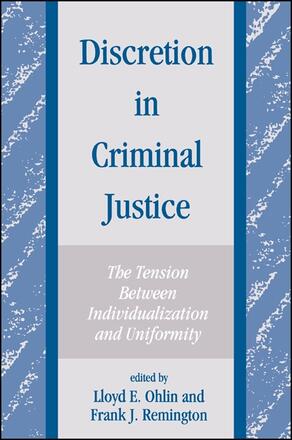Acknowledgments
Foreword by Michael Tonry
1. Surveying Discretion by Criminal Justice Decision Makers
Lloyd E. Ohlin
The American Bar Foundation Survey
The Survey Origins
Research Methodology
Major Observations of the Survey
The Pilot Project Reports and the Survey Books
The Impact of Ideology on Practice and Research
Policy Choices
2. Confronting the Complexity of the Policing Function
Herman Goldstein
Introduction
The State of Knowledge Before the ABF Survey
The American Bar Foundation Survey
Methodology
Substantive Findings
Developments Since the ABF Survey
The Varied Nature of the Police Function
The Infinite Variety of Situations Police Are Called on to Handle
The Varied Uses of Arrest
The Prevalence of Discretion on Policing
The Police Decision Not to Arrest
The Criminal Justice System as a System
Conclusion
3. The Decision to Charge, the Decision to Convict on a Plea of Guilty, and the Impact of Sentence Structure on Prosecution Practices
Frank J. Remington
Introduction
The Charging and Guilty Plea Decisions as Seen in the Pre-ABF Research
The Charging Decision
The Guilty Plea Decision
Summary
The Charging and Guilty Plea Decisions in the ABF Research
The Charging Decision
The Guilty Plea Decision
Lessons Learned in the ABF Research on Charging and Guilty Plea Decisions
Post-ABF Developments
The Charging Decision
The Guilty Plea Decision
The Changing of Roles of Trial Judge, Prosecuter, Defense Counsel, and Victim in the Charging and Guilty Plea Decisions
Conclusion
4. Sentencing, Parole, and Community Supervision
Walter J. Dickey
Introduction
Pre-ABF Research and Developments
Classical and Positivist Theories
Implementation of Rehabilitative Theory in American Practices
Ideological Framework of the Pre-ABF Research
Pre-ABF Research Findings
Sentencing Discretion in Pre-ABF Research
Conclusions on Pre-ABF Research
The American Bar Foundation Research
Trial Judge Sentencing in Wisconsin as Described by the ABF Research
Parole Release in Wisconsin
Probation and Parole Supervision in Wisconsin
Significance of the ABF Research
Post-ABF Research and Developments
The Experience in Wisconsin
After the ABF Survey--Sentencing and Parole Release
Conclusion: Discretion in Sentencing and Corrections on the National Scene
5. Criminal Justice Responses to Domestic Violence
Raymond I. Parnas
The ABF Survey's Contribution to Domestic Violence Issues
Related Developments on Domestic Violence Issues
Influences on the Development of Full Enforcement Policies
Research Findings on Full Enforcement
The Future: From Low Visibility to High Visibility; From Adjustment to Arrest; So What?
6. Police Rule Making and the Fourth Amendment: The Role of the Courts
Wayne R. LaFave
Police Rule Making and the Fourth Amendment
Impoundments and Inventories: The Bertine "Standardized Procedure" Requirement
Inspections: The Camera "Reasonable ...Administrative Standards" Requirement
Stops: By "Plan" or By "Profile"
Arrests: Police Limits on Force and Custody
The Role of the Courts to Date
Remaining Problem Areas
Denouement
7. The American Bar Foundation Survey and the Development of Criminal Justice Higher Education
Donald J. Newman
Criminal Justice Education
Development of Educational Materials
Summer Seminars for Legal and Social Science Scholars
Law Student Summer Field Placements in Criminal Justice Agencies
Problems with Teaching and Researching Criminal Justice in Law School Settings
Creation of the State University of New York and the First School of Criminal Justice
Governor Nelson Rockefeller and the State University of New York
Origins of the School of Criminal Justice at Albany
The Role of Eliot Lumbard
Meeting the Personnel Needs of Criminal Justice Agencies
Early Consultants to the Albany School
The Planning Year: Creation of the Albany Model
Criminal Justice Education Defined
Graduate Curriculum in Criminal Justice: The Albany Model
Structure of the School: Faculty and Student Criteria
The Albany School After Twenty Years
The Spread of Criminal Justice Higher Education
The Federal Office of Manpower and Training
Criminal Justice Education Proselytizers
The Creation of the Academy of Criminal Justice Sciences
Survival After the Demise of LEAA
Location and Identity in Universities and Colleges
Location on New and Secondary Campuses
Why Survival and Growth?
The American Bar Foundation Survey and Criminal Justice Education Today
Major Contributions of the ABF Survey to Criminal Justice Higher Education
Contrary Developments and Unanticipated Consequences in the Academic Field of Criminal Justice
The Future off Criminal Justice Education
Solidifying the Field
Location on Prestigious Campuses
New Student Populations
Curriculum Standardizations
Research Trends
Increased Professionalism of On-Line Personnel
Conclusion
Appendix A: About the Authors
Appendix B: Project Participants
Index
